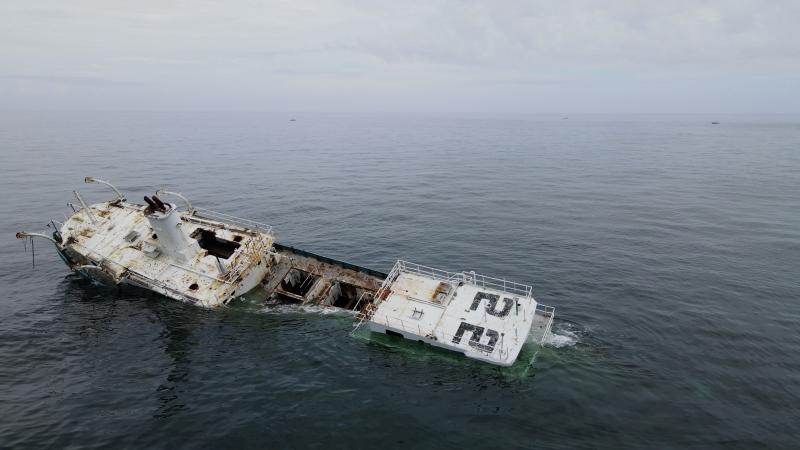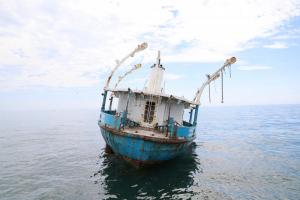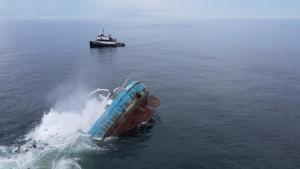DNREC adds ship to growing artificial reef
On Aug. 13, the Delaware Department of Natural Resources and Environmental Control sank the menhaden fishing boat Reedville at Reef Site 11. The coordinates of the sinking are N 38 40.423/ W 74 44.295. The ship sits in 87 feet of water and is 16 miles offshore from Indian River Inlet. She is 180 feet long and measures 38 feet from the keel to the top of the stack. With her cavernous hold, she is expected to be very attractive to both black sea bass and tog.
The Reedville was first commissioned as a Navy ship, then as an Army freight and supply vessel. When the ship was recommissioned as a menhaden purse seiner, she was named Reedville after the town in Virginia where the largest fish processing plant is located. The town is named after Capt. Elijah W. Reed, whose process for extracting fish oil from menhaden in the 19th century made him and the town very rich.
There are three other menhaden boats at Site 11 along with 997 New York subway cars, 86 Army tanks, eight tugboats, a fishing trawler and two barges. Last fall, a cruse ship was placed there as well.
The Reedville, along with several other ships, was prepared for sinking by Coleen Marine in Norfolk, Va. They purchase the ship and do all the work to get it ready to sink. Once it hits bottom, DNREC pays Coleen Marine for the work and the ship. In the case of the Reedville, the cost was $175,000. The money comes from the federal Sport Fish Restoration program (75 percent) and Delaware’s General Fishing License fees (25 percent).
Delaware’s reef program is by far the most successful on the Mid-Atlantic coast. We have productive reefs in the Delaware Bay and Atlantic Ocean where anglers can find a wide variety of fish from croakers to flounder to bluefish and dolphin.
Fishing report
We had a bit of a blow last weekend that stirred up the water, but not as much as the tropical storm did the previous week. We should get back to good fishing by midweek, and the weather looks good right through the weekend.
Bottom fishing in the ocean remains the best bet with flounder and black sea bass available in several locations. Both species are located on hard structure, be it over rough bottom at the Old Grounds or around B or A buoys, or at reef sites 10 and 11 or the Del-Jersey-Land.
Because the fish are on hard structure, you are going to lose rigs. No matter how good you think you are, and I think I am pretty good at feeling the bottom, you are going to get hung up. You can minimize your loss by paying attention to your rig and using braided line to help you feel what type of bottom you are on. With a little practice, you can feel the difference between sand, mud and hard structure, and be able to lift the rig the instant you feel the structure. You must constantly lift and lower your rig a few inches to keep feeling the bottom. Never, ever leave the rod in a holder and just let it drag across the bottom.
There is a certain feel you have to develop to tell a flounder take. When a flounder takes a bait, it will grab it sideways, then turn it before swallowing. This may only feel like a slight weight on the line. It only takes a few seconds, but if you strike before the fish has the hook in its mouth, you will miss it. A slight drop back will give the fish time to get the hook where it needs to be.
Black sea bass are not that fussy. They grab and go, and if you are using circle hooks, they will hook themselves.
Closer to shore, there are plenty of croaker, spot, kings and a few flounder at reef sites 8 and 5 in Delaware Bay. These same fish may be caught from shore at Broadkill Beach, the fishing pier at Cape Henlopen State Park and Lewes Beach. Bloodworms, clams, squid and live minnows plus FishBites and Gulp! will all attract these fish.
Surf fishing along the ocean front has been less than stellar. Kings and croaker have been caught on bloodworms, clams and FishBites, but they are few and far between. Being able to make long casts is a definite advantage when surf fishing right now.
Indian River Inlet is not exactly red-hot either. Blues have been taken on metal and bucktails during incoming water. A few keeper flounder are caught from the sidewalk along with some croaker. Live minnows for the flounder, bloodworms or FishBites for the croaker.
























































